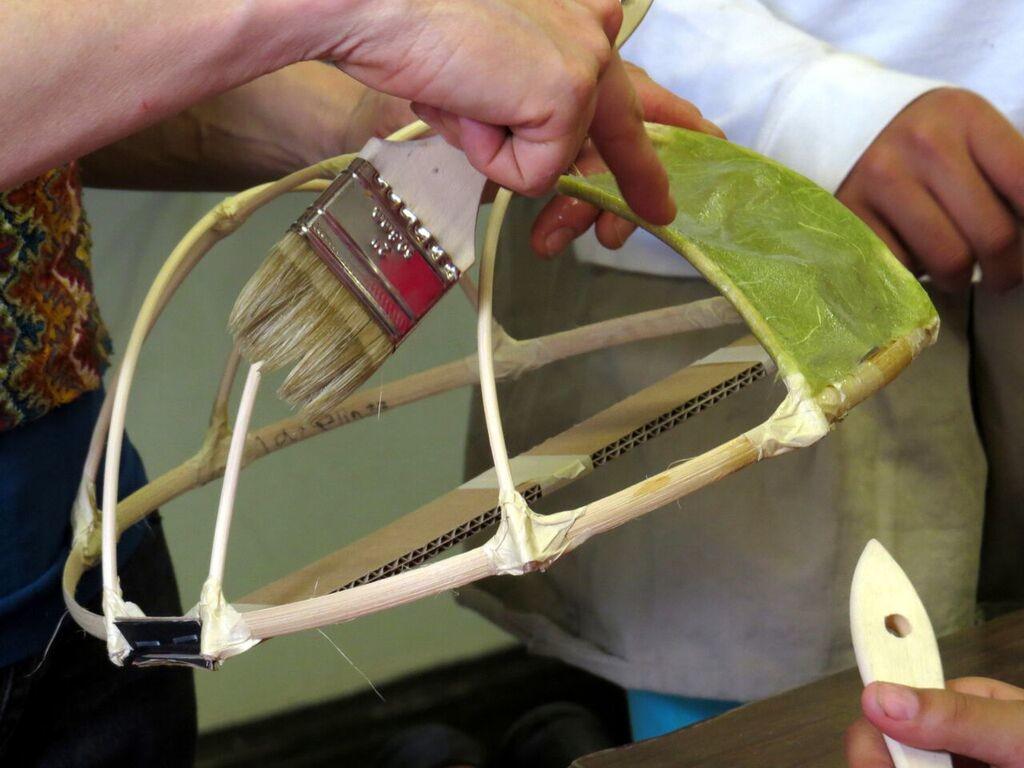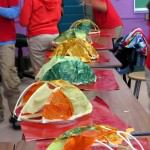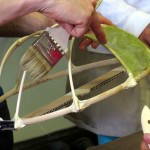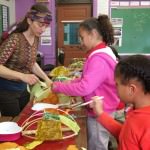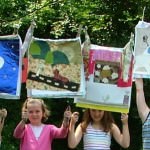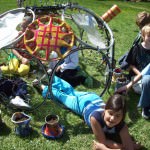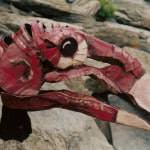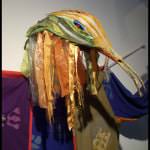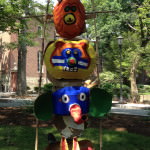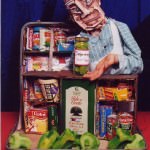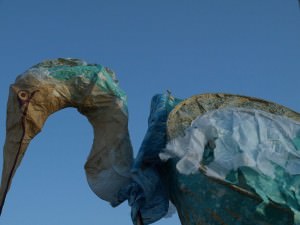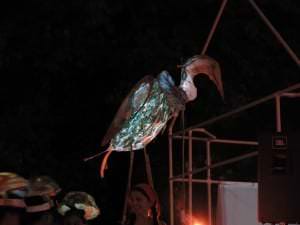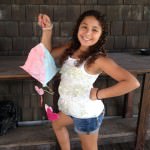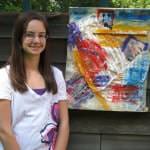This month we turn to a local artist who not only uses handmade paper as a material in her mixed media sculptures, but also uses it to teach young ones to respect the environment and become active participants in caring for it. Meet Lisa Abbatomarco and her unique approach to handmade paper. She has been an integral part of the Urban Pond Procession for the past 3 years. Last year Lisa completed a residency with the group in promoting the next generation to learn lantern making, creating puppets, all the while cherishing our precious planet.
PCI: Thank you so much for doing this interview, Lisa. Please describe what you do and how paper plays an intrinsic role in your artwork.
LA: I work with fiber arts, collage, sculpture, papier maché, I like to call it a “construction”, a combination of industrial materials, felt, wire, and paper. I’m doing construction, combining elements and textures that I like, whether in 2D or 3D form, it constantly evolves. I do a lot with kids, based in sculpture, puppetry, on an outdoor scale involving projects that bring awareness to various issues, like community, nature, and environmental concerns.
PCI: How has paper inspired you with such a wide choice of materials, especially for sculpture?
LA: I have always been interested in paper. I’m always the one saving the wrapping paper, from different objects, even candy wrappers. This has evolved to papier maché, with that top surface, top layer, turning into lanterns, puppets.
PCI: The Urban Pond Procession, based in Providence, cultivates awareness of local nature paths and waterways in famous Roger Williams Park by having children work on various art projects, culminating in the procession in the areas around Mashapaug Pond and Roger Williams Park. How do your lanterns and puppets configure in this annual event?
LA: I collaborate with a friend who is a story-teller, and the story telling culminates with a procession of lanterns and puppets. The forms, which can be puppets, characters, using reed as an overhead frame, and handmade paper, light up at night. The kids play with the paper, with the concept of creating lanterns-big or small-as imagery of bringing light, celebrating the night.
LA: Last year, 3 different residencies and 3 different schools all came together to Urban Pond Procession. A personal awareness is involved, as there are neighborhoods surrounding the pond, and local wild life.
PCI: How often do you decide to use paper for the puppets and lanterns?
LA: I kind of like to say it is “structured improvisation”. Sometimes it depends on the length of the workshop. It can be simple to extensive. I tend to work with a theme in mind. For example, we’re going to work with Calder. His free form helps me to ask, “How many ways can I make a lantern?” The annual event of the Pond Procession celebrates the pond, and we are constantly deepening the process. To celebrate the night, we revolve around the idea of constellations. The process is constantly deepening.
PCI: How were you introduced to Paper Connection? How have our papers enhanced your method or approach?
LA: I knew an old friend, Joanne, who knew you. I go to Paper Connection without a goal, because there are so many pretty things. Like we’re doing turtles, colorful fish, what kind of papers can I use? It’s a good thing you don’t let us go in the back!
PCI: Being in our paper warehouse is exactly like being a kid in a candy shop, that’s why non-staff are not allowed in the back; it’s way too tempting. 🙂
Is it love at first sight when you see a particular paper? Does the idea come first and then you decide on what you will use, or do you choose the paper first, knowing that it will yield the results you desire?
LA: Now that I have been there, (to the warehouse), I know which papers will work. I am usually on a budget, so I know, okay, I can look at these papers. For my own personal project, I will look at the paper and ask, what’s speaking to me?
It’s very intuitive for me, and I get really excited about pattern. One time when you brought back a paper hat from Japan, and folded wallets, it got me very excited. These beautiful objects made me want to make paper.
PCI: How are you able to explain the importance of handmade paper to your younger students?
LA: What I like to do is explain how the papers are made so they have more of an appreciation for it. This really should be brought to their attention. I do tell them how much it costs, and $4 per sheet is shocking to them. But it would be a great thing to have them understand the concept of bringing old art forms back that require the hand to make them. Some of it is preservation. There’s a history to it, and all of that fits into what I teach. It doesn’t just appear. There is a process of getting a nice material before turning it into a nice project. What I like about Paper Connection is that somebody’s daily livelihood is affected. They spend their day making this. All of the work uses recycled and sustainable materials. So with the paper, we save scraps. We always have a scrap box, cut out what we want, and we collect sticks found in the woods, recycled wire. I find it easier to pull from things that already exist.
PCI: So at the same time, you are inculcating the principle of being resourceful, and responsible to the children you teach. How do they react to the paper?
LA: Like a candy store! It’s really fun. When I unroll colorful papers, they dive into it. It’s like a jewel. They gasp. The same goes for adults, actually. And I have to choose vibrant colors. I love the gorgeous white, elegant papers, but kids respond to colors.
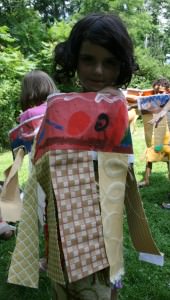
PCI: What challenges exist in teaching novices how to work with specialty papers?
LA: I hear a lot of “I’m not good at putting the paper on this…or that…” but I ask, “Have you ever done it before?” I have to say, let yourself be new. Be the baby at something. You don’t know until you do it the next time. If the paper gets wrinkly, you will love the wrinkles. You work with the accidents.
PCI: What advice would you give to someone who is following in your footsteps?
LA: Give yourself room to explore. It’s very important. There’s a misunderstanding that you pick something up and get it right the first time, at any age. Kids can be quick to say, “I’m not good at gluing!” But I ask them, “Well, how often do you glue?”
PCI: And what about the use of handmade paper for lanterns and puppets?
LA: Notice the weight, the thickness. I’m particular about weights. For lanterns, I hold the paper up to the light, move it around. Perhaps it works for this form but not enough light goes through it, for example. You have to use the right tools for the job so you get the most out of the material. Allow the material to show you what you can do with it. Paper is a tactile thing. Explore it and take the time to be with it. Let your senses guide you.
PCI: Which artist has inspired you?
LA: Louise Nevelson, a sculptor who works in printmaking, then wood and metal for large scale installations that are very geometric, monolithic at times. There’s an element of being indigenous, a quality at being present, that also carries in her person.
PCI: Well, we see that your enthusiasm for teaching and your love for paper carries in yours, and is evident in our local Providence community. Thank you so much.
Lisa will be teaching classes for both children and adults at Cutler Mills, in Warren, RI.
For more on Lisa please visit:

